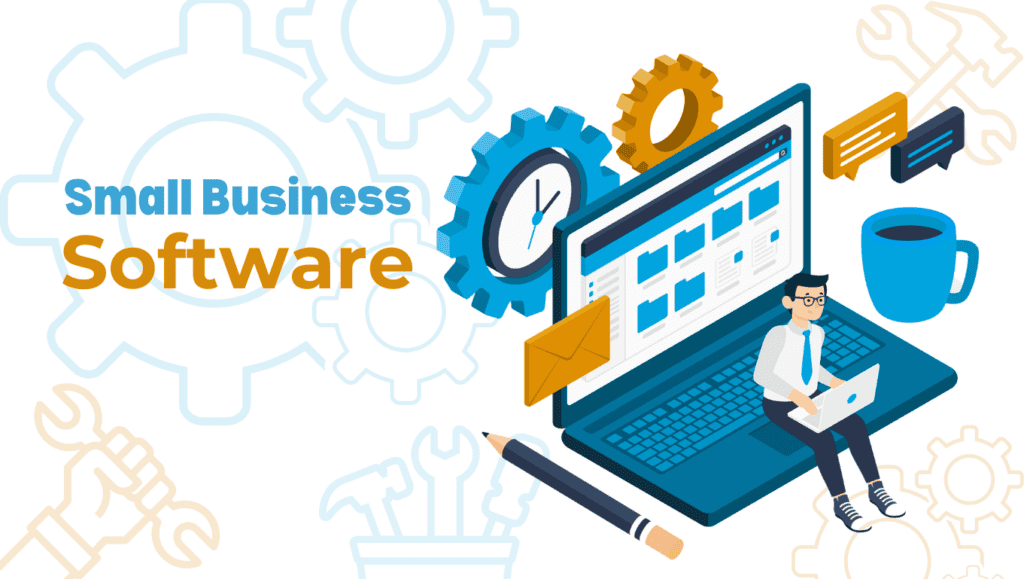Are you a small business owner striving to stay ahead in today’s competitive landscape? Are you struggling to manage various aspects of your business efficiently and looking for ways to make your business grow? The key to unlocking your business’s full potential lies in leveraging the right tools.
There are a lot of business tools for small businesses online. In this comprehensive guide, we unveil the top 55 essential business tools designed to meet every small business needs. From Sales and Marketing to tracking tools, we’ve got you covered. Let’s dive into the world of small business tools and discover how they can transform your business.
Table of Contents
- Some of the best small business management tools and Software
- A. Sales and Marketing Tools For Small Business:
- B. Productivity And Collaboration Tools:
- C. Project Management Tools For Small Businesses:
- D. Best Small Business Tools For Communication:
- E. Customer Relationship Management (CRM) Tools:
- F. Best Tools For E-commerce:
- G. Accounting Software and Financial Tools:
- H. Operations Management Tools For Small Business Owners:
- I. Human Resources (HR) Tools:
- J. Tracking And Analytics Tools:
- 7 Benefits of Small Business Tools and Software in Your Business
- 5 Things to Consider When Choosing Business Tools and Software
- Case Studies: Unveiling Real-World Success Stories
- Conclusion:
Some of the best small business management tools and Software
Below are some important startup or small business software. These tools cover a range of functionalities within each category, providing small businesses with diverse options to meet their specific needs and preferences.
- A. Sales and Marketing tools for small business
- B. Productivity tools
- C. Project management tools
- D. Communication tools
- E. Collaboration tools
- F. Customer relationship management (CRM) tools
- G. E-commerce tools
- H. Accounting and Financial tools
- I. Operations Management tools
- J. Human resources (HR) tools
- K. Tracking and Analytics Tools
A. Sales and Marketing Tools For Small Business:
Sales and Marketing Tools comprise software designed to streamline lead generation, customer relationship management, and marketing execution. This suite helps small businesses to attract, engage, and retain customers effectively.

1. Explainer Video:
An explainer video is a concise visual representation explaining a product, service, or concept. It simplifies complex ideas, engages audiences, and often serves as an introduction to a company’s offerings. This is one of the best small business tools to help businesses easily reach their goals. 96% of people have watched an explainer video to learn more about a product or service, also 88% of people say that they’ve been convinced to buy a product or service by watching a brand’s video.
Key Features:
- Concise storytelling for easy understanding.
- Engaging visuals to capture the audience’s attention.
- Clarity in presenting complex concepts or products.
2. HubSpot:
HubSpot is an integrated platform offering inbound marketing, sales, and service tools. It streamlines customer interactions, providing CRM, marketing automation, and sales tools in one place.
Key Features:
- Unified CRM for streamlined customer interactions.
- Marketing automation to nurture leads and create personalized campaigns.
- Sales tools for efficient deal management and task organization.
3. Mailchimp:
Mailchimp is an email marketing tool facilitating campaign creation, automation, and analytics. It simplifies marketing efforts, offering a user-friendly drag-and-drop email builder for targeted and data-driven campaigns.
Key Features:
- Intuitive email builder for seamless campaign creation.
- Marketing automation for personalized and timely messaging.
- Analytics tools to track campaign performance and customer engagement.
4. Salesforce:
Salesforce is a cloud-based CRM platform providing a 360-degree view of customers. It empowers businesses with customizable CRM, sales automation, and marketing tools for data-driven decision-making and customer relationship management.
Key Features:
- Customizable CRM adapting to unique business needs.
- Sales Cloud for automating and optimizing sales processes.
- Marketing Cloud for creating personalized, targeted marketing campaigns.
5. Hootsuite Social Media Management Software:
Hootsuite is a social media management platform, simplifying content scheduling, monitoring, and analytics. It enhances social media marketing efforts with efficient content planning, performance analytics, and collaboration tools.
Key Features:
- Social media scheduling for streamlined content planning.
- Analytics tools for measuring social media performance and ROI.
- Collaboration features for managing social media teams efficiently.
B. Productivity And Collaboration Tools:
Productivity Tools are software solutions designed to enhance efficiency and collaboration within teams, facilitating task management, project coordination, and seamless communication to optimize workflow and output.
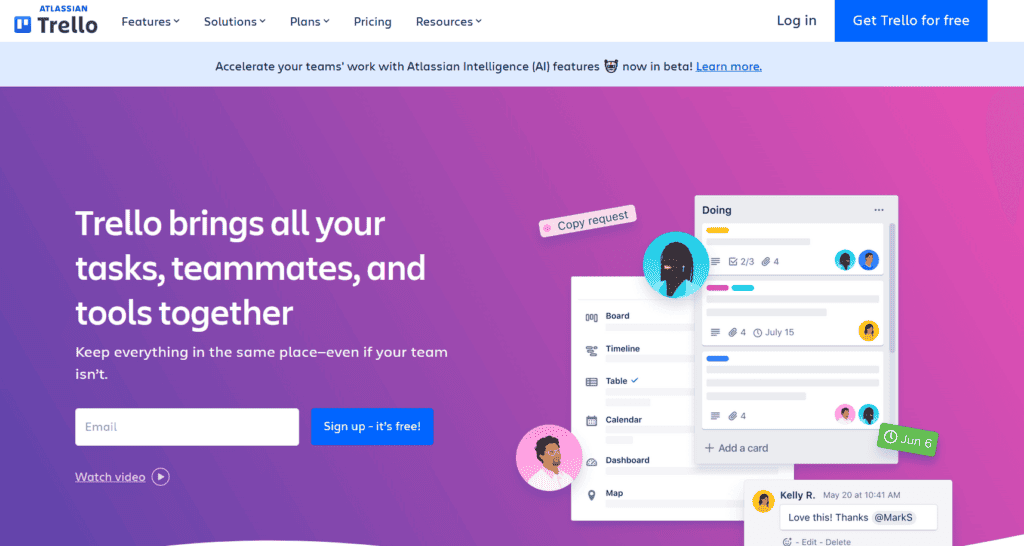
6. Trello:
Trello is a visual project management tool utilizing boards, lists, and cards to organize tasks collaboratively. It offers an intuitive platform for managing projects with flexibility and simplicity.
Key Features:
- Visual boards for clear task organization.
- Drag-and-drop functionality for easy task management.
- Collaborative features for team communication and coordination.
7. Asana:
Asana is a project management platform enabling teams to organize and track work. It provides a flexible and user-friendly interface to manage tasks, projects, and team collaboration efficiently.
Key Features:
- Task tracking and project management with customizable workflows.
- Team collaboration through shared projects and communication tools.
- Automations for streamlining repetitive tasks and processes.
8. Notion:
Notion is an all-in-one workspace allowing users or businesses to create notes, documents, and databases. It promotes collaboration by integrating these elements into a unified platform for seamless information sharing and project management.
Key Features:
- Versatile workspace for notes, documents, and databases.
- Collaborative features like real-time editing and comments.
- Customizable templates for various project and workflow needs.
9. Microsoft 365:
Microsoft 365 is a comprehensive suite offering productivity tools like Word, Excel, and Teams. It provides a cloud-based solution for document creation, collaboration, communication, and project management within a unified environment.
Key Features:
- Word, Excel, PowerPoint for document creation and collaboration.
- Teams for communication and virtual collaboration.
- Cloud storage for seamless access and sharing of documents.
10. Google Workspace:
Google Workspace (formerly G Suite) is a cloud-based collaboration and productivity platform. It integrates tools like Docs, Sheets, and Gmail, fostering real-time collaboration, communication, and efficient document management.
Key Features:
- Collaborative document editing in real-time with Docs and Sheets.
- Gmail for efficient communication and integrated calendar features.
- Cloud storage for easy access and sharing of documents and files.
11. Miro:
Miro is a digital collaboration platform for visual collaboration and brainstorming. It offers virtual whiteboards, diagrams, and templates, facilitating remote collaboration, ideation, and project planning.
Key Features:
- Virtual whiteboards for visual collaboration.
- Templates for various brainstorming and planning activities.
- Real-time collaboration for distributed teams.
C. Project Management Tools For Small Businesses:
Project Management Tools are software applications designed to help teams plan, organize, and execute projects efficiently, facilitating collaboration, task tracking, and overall project coordination.
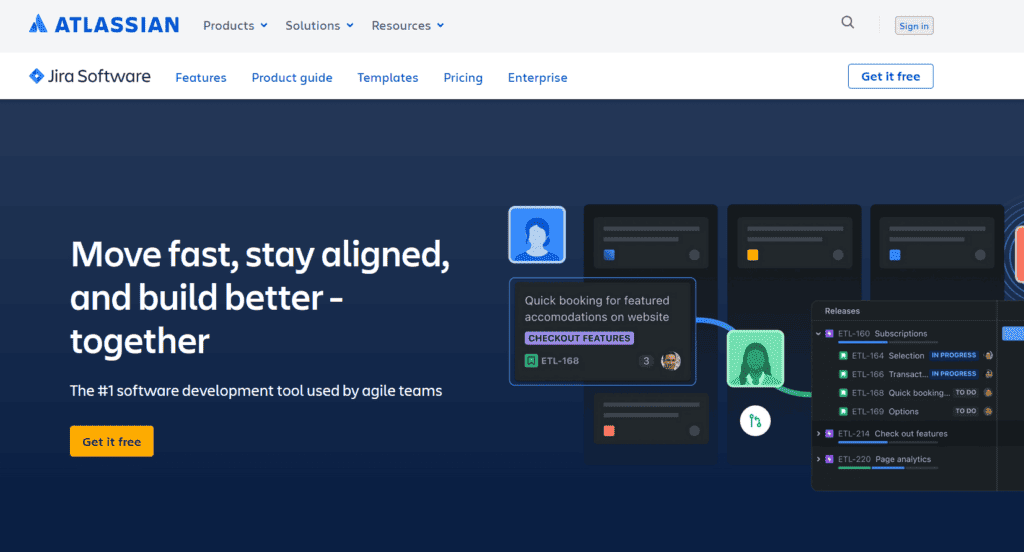
12. Jira:
Jira is a powerful agile project management tool. It enables teams to plan, track, and manage projects with advanced features tailored for software development and agile methodologies.
Key Features:
- Agile project management with Scrum and Kanban boards.
- Advanced issue tracking and customizable workflows.
- Integration capabilities with third-party tools for enhanced functionality.
13. Monday.com:
Monday.com is a work operating system that simplifies project and team management. It provides a visual platform with customizable workflows, fostering collaboration, transparency, and efficient task tracking.
Key Features:
- Visual project tracking with customizable boards.
- Workflow automation for streamlined task management.
- Collaborative features for team communication and real-time updates.
14. Basecamp:
Basecamp is an all-in-one project management and collaboration tool. It centralizes communication, tasks, and project files, providing a straightforward platform for teams to stay organized and connected.
Key Features:
- Centralized project communication with message boards.
- To-do lists and scheduling for task management.
- File storage and sharing for collaborative project documentation.
15. Wrike:
Wrike is a versatile project management and collaboration platform. It offers tools for project planning, task tracking, and real-time collaboration, enhancing team efficiency and project visibility.
Key Features:
- Interactive Gantt charts for project planning.
- Task management with real-time collaboration features.
- Customizable dashboards and reporting for project insights.
16. Smartsheet:
Smartsheet is a collaboration and work execution platform. It combines the flexibility of spreadsheets with project management tools, offering a dynamic platform for planning, tracking, and managing work.
Key Features:
- Grid-based structure for versatile project tracking.
- Automated workflows for efficient task management.
- Collaboration features with real-time updates and commenting.
D. Best Small Business Tools For Communication:
Communication Tools are platforms designed to facilitate real-time interaction, messaging, and collaboration within teams, improving overall communication, and fostering efficient teamwork.
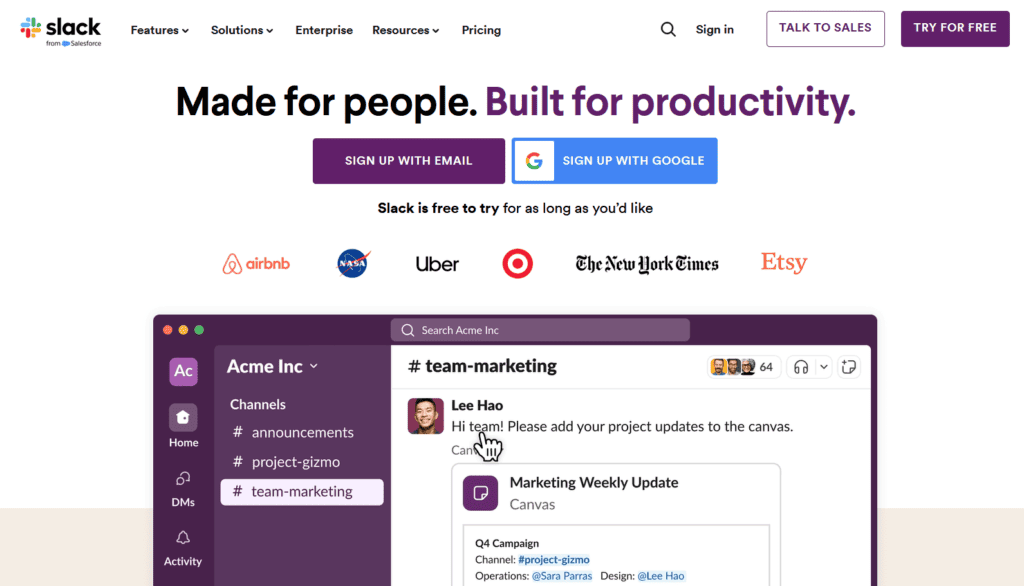
17. Slack:
Slack is a collaboration hub that streamlines team communication. It offers channels, direct messaging, and integrations, enhancing collaboration, file sharing, and information exchange in real time.
Key Features:
- Channels for organized team communication.
- Direct messaging for one-on-one conversations.
- File sharing and integration with third-party tools.
18. Microsoft Teams:
Microsoft Teams is a collaboration platform integrated with Microsoft 365. It combines chat, video conferencing, file storage, and app integration, fostering seamless communication and collaboration within teams.
Key Features:
- Chat and threaded conversations for organized communication.
- Video conferencing for virtual team meetings.
- Integration with Microsoft 365 apps for collaborative work.
19. Zoom:
Zoom is a video conferencing platform that facilitates virtual meetings, webinars, and collaboration. It provides a reliable and user-friendly environment for team communication and remote collaboration.
Key Features:
- High-quality video and audio for virtual meetings.
- Screen sharing for collaborative presentations.
- Webinar capabilities for large-scale virtual events.
20. Skype:
Skype is a communication platform for messaging, voice, and video calls. It offers instant messaging, file sharing, and conference calls, facilitating real-time communication and collaboration.
Key Features:
- Instant messaging for quick communication.
- Voice and video calls for remote collaboration.
- File sharing for easy information exchange.
21. Discord:
Discord is a communication platform popular in gaming communities. It provides voice, video, and text communication channels, fostering real-time collaboration and interaction within communities and teams.
Key Features:
- Voice and video channels for live communication.
- Text channels for asynchronous messaging.
- Community management features for organizing and moderating discussions.
E. Customer Relationship Management (CRM) Tools:
CRM Tools focus on managing and improving interactions with customers. They centralize customer data, enhance communication, and optimize sales processes for improved customer relationships.
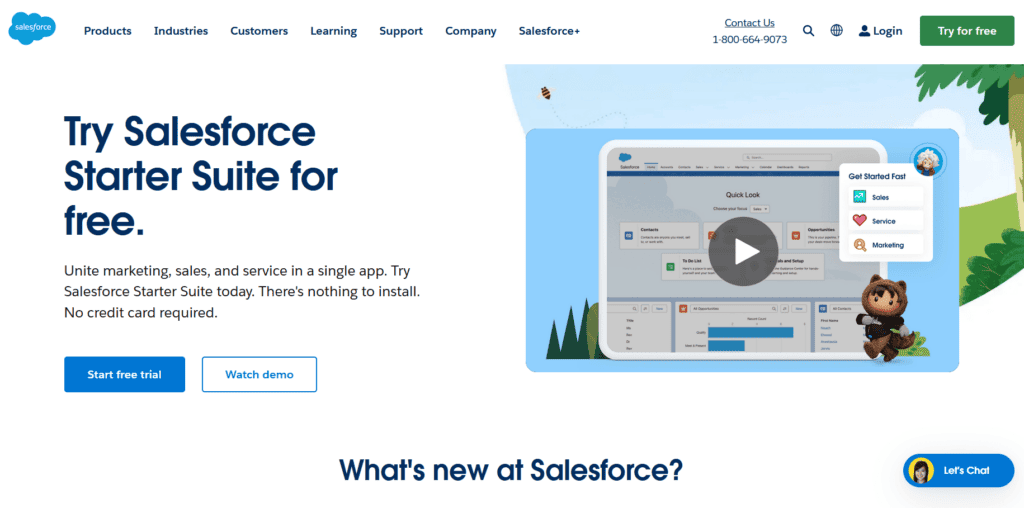
22. Salesforce:
Salesforce is a cloud-based CRM platform offering a comprehensive suite of tools for sales, marketing, and customer service. It centralizes customer data, streamlines workflows, and facilitates data-driven decision-making.
Key Features:
Customizable CRM adapting to unique business needs.
Sales Cloud for automating and optimizing sales processes.
Marketing Cloud for creating personalized, targeted marketing campaigns.
23. HubSpot CRM:
HubSpot CRM is an integrated platform providing CRM, marketing, and sales tools. It focuses on simplicity and user-friendliness, offering features for contact management, deal tracking, and lead nurturing.
Key Features:
- Unified CRM for streamlined customer interactions.
- Marketing automation to nurture leads and create personalized campaigns.
- Sales tools for efficient deal management and task organization.
24. Zoho CRM:
Zoho CRM is a cloud-based CRM solution that streamlines sales processes and enhances customer relationships. It offers features for lead management, sales automation, and multichannel communication.
Key Features:
- Lead and contact management for effective sales processes.
- Sales automation for optimizing deal workflows.
- Communication tools for multichannel engagement.
25. Freshworks CRM:
Freshworks CRM is a customer engagement platform offering solutions for sales, marketing, and customer support. It provides features for lead scoring, email tracking, and collaboration to enhance customer interactions.
Key Features:
- 360-degree view of customer interactions for better insights.
- AI-based lead scoring for prioritizing sales efforts.
- Collaborative tools for team communication and coordination.
26. Pipedrive:
Pipedrive is a sales-focused CRM designed to improve deal management and sales processes. It offers features for pipeline visualization, automation, and detailed reporting for effective sales management.
Key Features:
- Visual pipeline for transparent deal tracking.
- Automation for streamlining repetitive sales tasks.
- Customizable reporting for data-driven decision-making.
F. Best Tools For E-commerce:
E-commerce Tools facilitate online selling by providing platforms for creating, managing, and optimizing online stores. They offer features for product listing, payment processing, and order management.

27. Shopify:
Shopify is a complete e-commerce platform that simplifies online store creation and management. It offers a user-friendly interface, customizable templates, and features for product listing, payment processing, and order tracking.
Key Features:
- Easy-to-use platform for store setup and customization.
- Secure payment processing with various payment gateways.
- Inventory management and order tracking for streamlined operations.
28. WooCommerce:
WooCommerce is a WordPress plugin that transforms websites into fully functional online stores. It provides features for product management, secure transactions, and order fulfillment, seamlessly integrating with WordPress.
Key Features:
- Integration with WordPress for easy setup and customization.
- Product management and listing with various customization options.
- Secure payment processing and order fulfillment features.
29. BigCommerce:
BigCommerce is a cloud-based e-commerce platform designed for scalability. It offers features for building and managing online stores, with customization options, secure payment processing, and robust analytics.
Key Features:
- Scalable platform suitable for growing businesses.
- Customizable storefronts with various design options.
- Secure payment processing and in-depth analytics for performance insights.
30. Magento:
Magento is an open-source e-commerce platform with a focus on customization and flexibility. It provides features for building online stores, managing products, and optimizing user experiences.
Key Features:
- Open-source platform for extensive customization.
- Product management with advanced options and configurations.
- Scalable architecture suitable for businesses of all sizes.
31. Square:
Square is an integrated payment and e-commerce solution. It offers features for online store creation, payment processing, and point-of-sale systems, providing a unified platform for businesses to manage both online and offline transactions.
Key Features:
- Integrated payment processing for online and offline transactions.
- An easy-to-use platform for creating and managing online stores.
- Point-of-sale solutions for in-person transactions.
G. Accounting Software and Financial Tools:
Accounting and Financial Tools assist businesses in managing their financial transactions, budgeting, and overall financial health. They offer features for invoicing, expense tracking, and financial reporting.
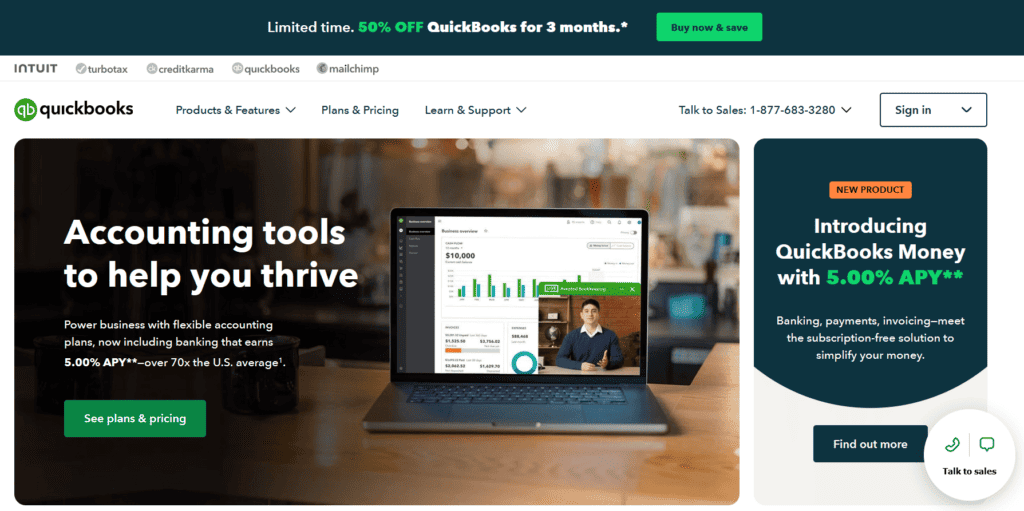
32. QuickBooks:
QuickBooks is an accounting software providing tools for invoicing, expense tracking, and financial reporting. It is designed for small businesses and offers a user-friendly interface for effective financial management.
Key Features:
- Invoicing and payment tracking for efficient financial transactions.
- Expense tracking and categorization for accurate financial reporting.
- Financial reporting tools for insights into business performance.
33. Xero:
Xero is a cloud-based accounting platform offering tools for invoicing, bank reconciliation, and financial reporting. It provides a real-time view of financial data, facilitating effective financial management for businesses.
Key Features:
- Invoicing and billing tools for streamlined financial transactions.
- Bank reconciliation features for accurate financial records.
- Financial reporting for insights into business finances.
34. FreshBooks:
FreshBooks is an accounting and invoicing software designed for small businesses and freelancers. It offers features for time tracking, expense management, and professional invoicing for efficient financial management.
Key Features:
- Invoicing and payment tracking for timely transactions.
- Time tracking and expense management for accurate billing.
- Financial reporting tools for insights into business finances.
35. Wave:
Wave is a free accounting software with tools for invoicing, accounting, and receipt scanning. It caters to small businesses and freelancers, providing essential features for effective financial management.
Key Features:
- Invoicing and payment tracking for small business transactions.
- Accounting tools for managing financial records.
- Receipt scanning for easy expense tracking.
36. Zoho Books:
Zoho Books is an online accounting software providing tools for invoicing, expense tracking, and financial reporting. It offers features for efficient financial management, suitable for small and medium-sized businesses.
Key Features:
- Invoicing and payment tracking for streamlined financial transactions.
- Expense tracking and categorization for accurate financial records.
- Financial reporting tools for insights into business finances.
H. Operations Management Tools For Small Business Owners:
Operations Management Tools focus on optimizing and streamlining various business operations, including project management, inventory control, and resource planning, to improve overall efficiency.
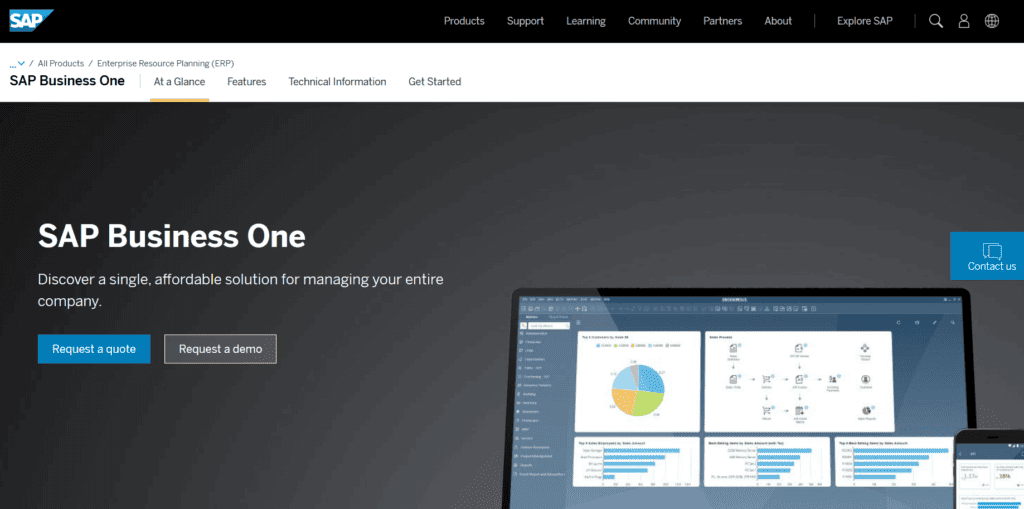
37. SAP Business One:
SAP Business One is an integrated business management solution for small and medium-sized enterprises. It offers tools for ERP, finance, inventory, and CRM, providing a unified platform for efficient operations.
Key Features:
- ERP tools for streamlined business processes.
- Inventory management for optimized stock control.
- CRM tools for enhanced customer relationship management.
38. Odoo:
Odoo is an open-source business management suite providing modules for various business functions. It offers tools for CRM, project management, inventory, and accounting, fostering integrated and efficient business operations.
Key Features:
- Modular structure for customizable business solutions.
- Project management and task tracking for streamlined operations.
- Inventory and warehouse management for optimized stock control.
39. NetSuite:
NetSuite is a cloud-based ERP solution offering tools for finance, CRM, and e-commerce. It provides a unified platform for businesses to manage various aspects, including financials, customer relationships, and operations.
Key Features:
- Integrated financial management for accurate accounting.
- CRM tools for improved customer relationship management.
- E-commerce solutions for online business operations.
40. Scoro:
Scoro is an all-in-one business management software focusing on project and work management. It provides features for project planning, time tracking, and collaboration, ensuring efficient and transparent business operations.
Key Features:
- Project and task management for streamlined workflows.
- Time tracking and resource planning for optimized operations.
- Collaborative tools for team communication and coordination.
41. Fishbowl:
Fishbowl is an inventory management solution designed for small to midsize businesses. It provides tools for inventory control, order management, and manufacturing, enhancing overall operational efficiency.
Key Features:
- Inventory tracking for optimized stock control.
- Order management tools for efficient order processing.
- Manufacturing features for streamlined production processes.
I. Human Resources (HR) Tools:
HR Tools assist in managing various human resource functions, including employee onboarding, time tracking, payroll, and performance management, fostering efficient and organized HR processes.

42. BambooHR:
BambooHR is a cloud-based HR software offering tools for employee management, onboarding, and performance tracking. It simplifies HR processes, enhancing employee data management and overall HR efficiency.
Key Features:
- Centralized employee database for streamlined HR processes.
- Onboarding tools for efficient new employee integration.
- Performance tracking and management for employee development.
43. Workday:
Workday is a cloud-based HR and finance solution providing tools for HR management, payroll, and financial tracking. It offers features for employee data management, talent acquisition, and workforce planning.
Key Features:
- Unified HR and finance solution for streamlined processes.
- Talent acquisition tools for effective workforce planning.
- Employee data management for comprehensive HR functions.
44. ADP:
ADP is a comprehensive HR and payroll solution for businesses of all sizes. It offers tools for payroll processing, time tracking, and HR management, ensuring accurate and efficient HR and payroll processes.
Key Features:
- Payroll processing for accurate and timely payments.
- Time tracking tools for efficient workforce management.
- HR management features for comprehensive HR functions.
45. Gusto:
Gusto is a cloud-based payroll and HR platform designed for small businesses. It provides tools for payroll processing, benefits administration, and employee onboarding, ensuring accurate and efficient HR and payroll processes.
Key Features:
- Payroll processing for accurate and timely payments.
- Benefits administration for comprehensive employee management.
- Employee onboarding tools for efficient new employee integration.
46. Zenefits:
Zenefits is an all-in-one HR platform offering tools for payroll, benefits administration, and HR management. It provides a unified solution for businesses to manage various HR functions in one place.
Key Features:
- Payroll processing for accurate and timely payments.
- Benefits administration for comprehensive employee management.
- HR management features for streamlined HR processes.
J. Tracking And Analytics Tools:
Tracking Tools are applications designed to monitor and analyze various aspects of business operations, including website analytics, time tracking, project and task tracking, order and shipment tracking, and expense tracking.
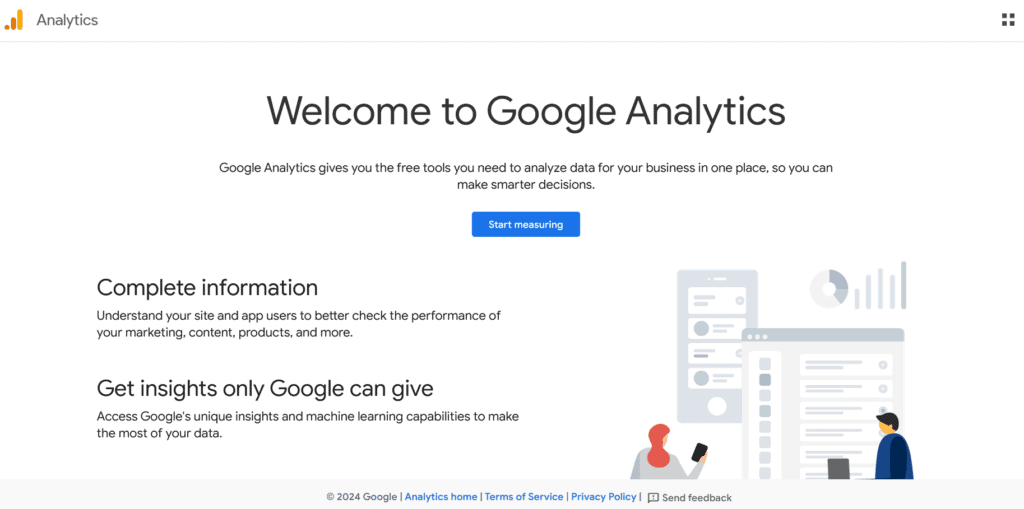
47. Google Analytics:
Google Analytics is a web analytics service by Google. It provides detailed statistics and analytics for website traffic, user behavior, and performance, offering insights to optimize online presence.
Key Features:
- Comprehensive website traffic analysis.
- User behavior tracking for insights into user interactions.
- Performance analytics for optimizing online presence.
48. Toggl:
Toggl is a time tracking tool that helps individuals and teams track work hours. It offers features for time entry, project tracking, and reporting, enhancing productivity and project management.
Key Features:
- Simple time entry for accurate work hour tracking.
- Project tracking and categorization for organized time management.
- Reporting tools for insights into time allocation and project progress.
49. Bitrix24:
Bitrix24 is a collaboration and project management platform that includes tools for project and task tracking. It provides features for collaboration, communication, and detailed project and task management.
Key Features:
- Task tracking and management for organized project workflows.
- Collaborative tools for team communication and coordination.
- Project management features for comprehensive project tracking.
50. ShipStation:
ShipStation is an order and shipment tracking platform for e-commerce businesses. It streamlines order fulfillment, provides shipping solutions, and offers features for tracking and managing shipments.
Key Features:
- Order management and fulfillment tools.
- Integration with various shipping carriers for flexibility.
- Shipment tracking for transparency in delivery processes.
51. Expensify:
Expensify is an expense tracking and management tool. It simplifies the process of tracking and reporting expenses, offering features for receipt scanning, reimbursement, and expense reporting.
Key Features:
- Receipt scanning for easy expense tracking.
- Automated expense reporting for efficiency.
- Reimbursement tools for streamlined financial processes.
7 Benefits of Small Business Tools and Software in Your Business
1. Increased Efficiency:
Small business tools automate tasks, reducing manual effort and boosting productivity. With features like project management and task tracking, these tools help streamline operations and save valuable time.
2. Enhanced Decision-Making:
Analytics tools provide valuable insights into business performance. Small business owners can leverage data from tools like Google Analytics to make informed decisions, optimize strategies, and stay ahead of the competition.
3. Financial Management:
Accounting software is a game-changer for small business owners. It simplifies financial tasks, helps maintain accurate records, and ensures compliance with regulations. This, in turn, supports sound financial management and business growth.
4. Effective Marketing Strategies:
Marketing tools, such as email marketing platforms and social media management tools, empower small businesses to create targeted campaigns. These tools maximize reach, engage the audience, and contribute to the overall success of marketing initiatives.
5. Improved Collaboration:
Collaboration tools play a crucial role in fostering teamwork among employees, especially in remote or distributed work environments. With features like file sharing and communication platforms, small businesses can enhance collaboration and drive collective success.
6. Customer Relationship Management (CRM):
CRM software is designed to help small businesses build and maintain strong customer relationships. By managing customer interactions and tracking sales leads, businesses can provide personalized experiences, leading to increased customer loyalty and satisfaction.
7. Cost-Effective Solutions:
Small business tools often offer free plans or affordable pricing options, making them accessible to businesses of all sizes. This cost-effectiveness ensures that even startups or businesses with limited budgets can leverage powerful tools to manage their operations efficiently.
Incorporating these tools into your small business strategy can lead to a more streamlined and successful operation, addressing the diverse needs of small business owners.
5 Things to Consider When Choosing Business Tools and Software
1. Scalability
When selecting business tools, consider the scalability of the software to ensure it can grow with your business. Opt for solutions that accommodate increased data, users, and features as your business expands. Scalable tools provide flexibility and prevent the need for frequent software migrations.
2. Integration with Existing Systems
Compatibility with your existing systems is crucial to avoid disruptions in your workflow. Choose tools that seamlessly integrate with other applications your business relies on. This ensures a smooth transition and enhances overall productivity.
3. User-Friendliness
The effectiveness of a tool is dependent on how easily your team can adapt to it. Prioritize user-friendly interfaces to minimize the learning curve. Intuitive tools lead to faster adoption, allowing your team to leverage the full potential of the software.
4. Cost-Effectiveness
Evaluate the overall cost of implementing a tool, considering not only the initial investment but also ongoing expenses. Look for solutions that offer a balance between features and affordability. Some tools may have free plans or trial periods, allowing you to assess their suitability for your business.
5. Customer Support and Training Options
Effective customer support is vital, especially when encountering issues or needing assistance with the software. Choose tools that provide reliable customer support and comprehensive training options. This ensures that your team can effectively use the tools and troubleshoot any issues that may arise.
Case Studies: Unveiling Real-World Success Stories
Airbnb Marketing Video Case Study:
Established in 2008 as a pioneer in the “sharing economy,” Airbnb faced skepticism due to its unique concept of allowing people to rent out their homes online.
To dispel doubts, in 2014, Airbnb utilized marketing tools like explainer videos, which generated over 5.8 million views on YouTube alone.
The Result:
The results were impressive, Airbnb reported over 10 million guests and 550,000 properties listed worldwide in the same year, earning Airbnb the title of Inc.’s 2014 Company of the Year.
Conclusion:
In conclusion, the landscape of small business tools is vast and varied, offering solutions for every aspect of your business. By strategically implementing these tools, you can overcome challenges, streamline operations, and achieve sustainable growth. Remember, finding the right tools tailored to your business’s unique needs is key to unlocking your full potential.
Key Takeaways: A Quick Summary
- Choose scalable tools that can grow with your business.
- Prioritize user-friendly interfaces for faster adoption.
- Ensure seamless integration with existing systems.
- Evaluate the overall cost, considering both initial and ongoing expenses.
- Select tools with reliable customer support and training options.
By incorporating these tools into your business strategy, you’ll not only streamline your operations but also position your small business for long-term success.
Check out more insightful articles on our blog. If you’re interested in enhancing your business through animation, explore our guide on animation tips for beginners and pros.

